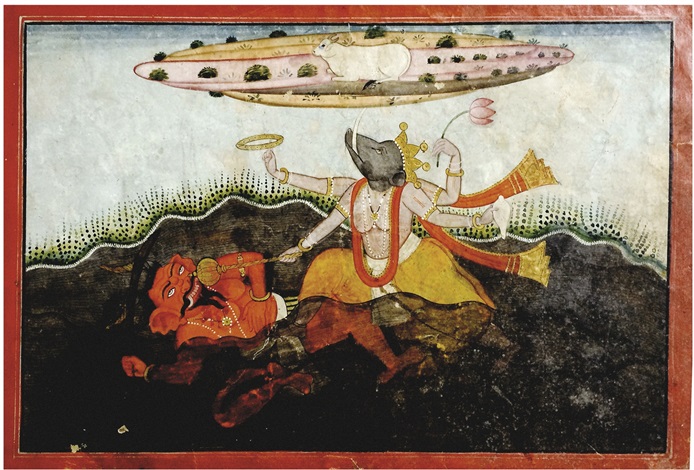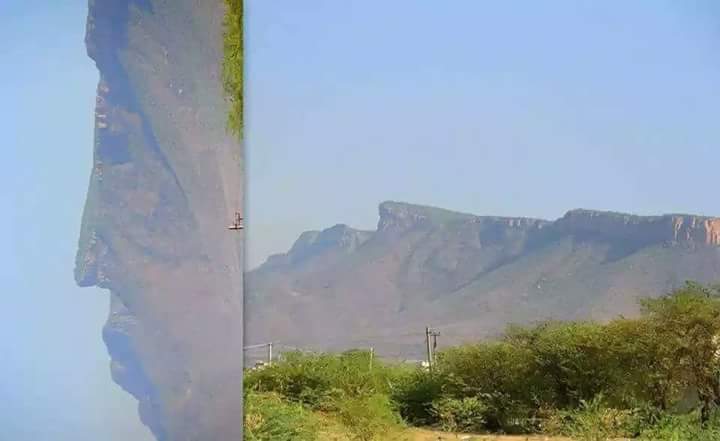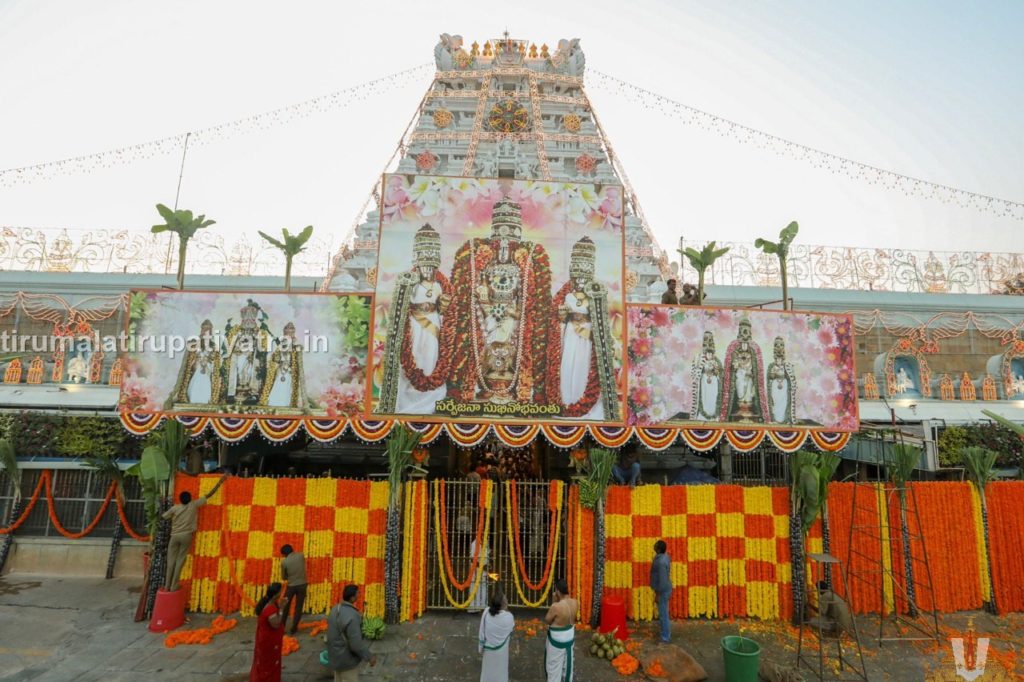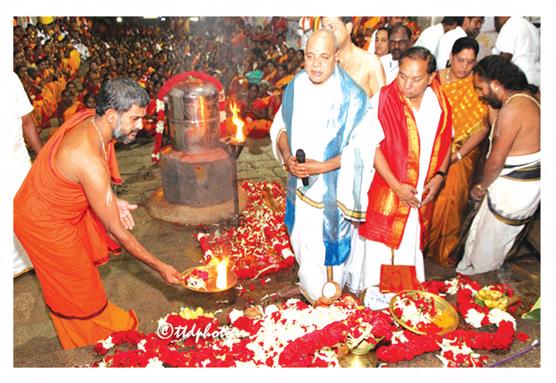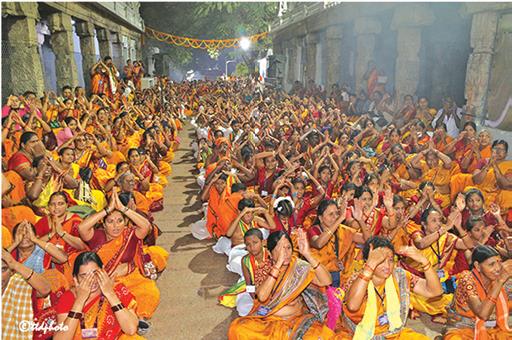Varaha Kshetram
The Seven Hills of Tirumala in total is being called ‘Varaha Kshetram‘. Sri Venkateswara Swami and Sri Varaha Swami temples are located here.
Having the first darshan of Lord Varaha Swami, the darshan of Sri Venkateswara Swami later by the devotees has been a practice for several years and is the specialty of this Kshetram. Then only fruitful results will be obtained for their visit to the Sacred Tirumala hills.
Sthala Puranam
The sthala mahatmyam of the temple of Sri Venkateswara is called ‘Sri Venkatachala Mahatmyam’. This is mentioned in several puranas like Varaha, Padma, Garuda, Brahma, Markandeya, Vamana, Brahmottara, Skanda, Aditya, Bhavishyottara and Harivamsa. Out of these, the most important are Varaha and Bhavishyottara puranas.
Sveta Varaha Kalpa
The 33rd Chapter of “Sri Varaha Purana” describing Sveta-Varaha’s slaying Hiranyaksha forms the first Chapter of “Sri Venkatachala Mahatmyam”. The sthala purana mentions a conference of all rishis, and munis at Naimisaranya, where Suta, the apara vedavyasa was asked to describe to the assembled saints about the pre-eminent kshetras sacred to Sri Mahavishnu.
The 36th Chapter of “Sri Varaha Purana” describes the divine grandeur of Sri Sveta Varaha Swami, who chose his abode on the Kridadri and forms the 4th Chapter of “Sri Venkatachala Mahatmyam”.
In as much as the hill is dearer to God and is encircled by the sacred crest, here lies the certainty of fructification of human efforts in the different spiritual fields, such as Mantra, Tapas, Yagna, Kamya and other siddhis (acquisitions) and no obstacles intervene. Even small deeds on this hill tend to the attainment of the desired objects. All holy tirthas abound on this hill.
A constant worshipper with faith and devotion, who desires knowledge obtains knowledge; who longs for riches acquires much gold; who desires children begets sons; who covets kingdom secures a state; who wishes for the removal of bodily deformity derives a perfect and lovely physique; and likewise whatever men may desire that they shall obtain.
Through various causes, the kridadri have different names for their significance and they are as follows:-
- Chintamani,
- Gnanadri,
- Tirthadri,
- Pushkaradri,
- Vrishadri or Dharmadri,
- Kanakadri,
- Narayanadri,
- Vaikuntadri,
- Simhachala,
- Anjanadri,
- Varahadri (for its being Varaha kshetra in it),
- Nilagiri,
- Venkatadri,
- Srinivasagiri,
- Anandadri,
- Sri-saila.
It possesses also admirable powers as multitudinous as God himself.
Its mahima is indescribable even by the four-faced Brahma, the six-faced Subrahmanya, the thousand-eyed Indra, or the thousand-hooded Adisesha. The rishis of Naimisaranya expressed their curiosity to Suta to know more. In addition to this, some engraved inscriptions on the pillars were found in the Tirumala temple.
There are other innumerable collections of legends and stories about Tirumala and the presiding God Sri Venkateswara or Srinivasa. Most of the incidents in the sthalapurana describe the sanctity and the greatness of the Hills of Tirumala and the numerous tirthas situated on them.
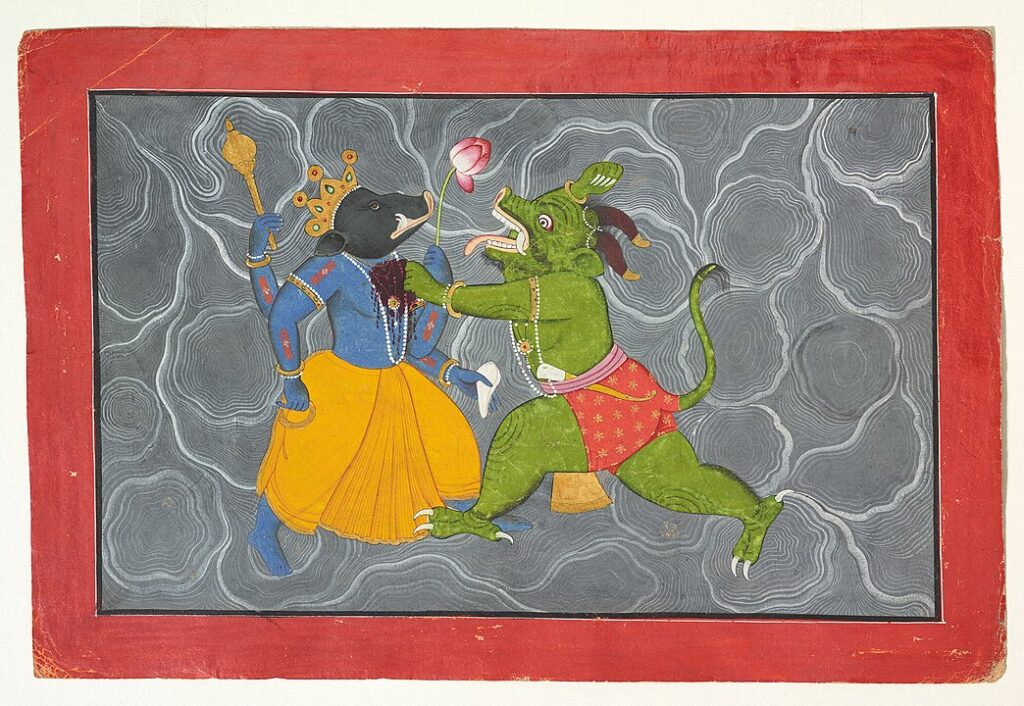
According to Legend…
Hiranyaksha was filled with pride, He once met Narada Maharshi and asked him “Is there anyone stronger than me”, then Narada replied, “Yes, There exists Lord Vishnu, who is stronger than you”. Hiranyaksha started searching for Lord Vishnu everywhere, but he couldn’t find him. He searched the whole earth and went underwater to Paatal Loka also for Lord Vishnu.
All the Gods were worried and rushed to Lord Vishnu for help. Oh! Lord! Please save us, Hiranyaksha has taken the earth and disappeared”. The Lord replied “Don’t worry, I know Hiranyaksha has taken the earth to paatal Loka. I’ll soon get the earth back to its position”. Then Lord Vishnu took the form of SwetaVaraha, a white boar with two curved tusks.
Lord then went to paatal loka. There was darkness in the depths in which the Earth was submerged. There, He found the earth hidden under seven underground worlds. Sri Varaha Swami fought and challenged Hiranyaksha. Hiranyaksha used many weapons, but it did not affect Lord Vishnu. Finally, Lord Vishnu directed his Chakra to Hiranyaksha, Chakra separated his head from the body. Hiranyaksha died then and there. Thus, Lord Vishnu relieved him from his curse.
![]()
Balancing the earth between the snout and the curved tusks, Lord Varaha brought Bhu Devi (earth) out of the depths of darkness and out of the deadly waters. As he rose out of the waters with the earth safe, those who witnessed the event praised God with gratitude. Then, the Varaha Swami placed her in the middle of the seas and supported her with his power.
Lord Sri Venkateswara took up residence in Tirumala, with the permission of Sri Varaha swami, and granted Lord Varaha, the privilege of first view (Darshan), and first Naivedyam. According to the legend, Tirumala was originally the Adi Varahakshetra. According to Brahma Purana, Naivedyam should first be offered to Sri Varaha swami. Pilgrims should visit Sri Adi Varahaswami temple before Sri Venkateswara Swami temple.
According to Atri Samhita, Varaha Avatara is worshipped in three ways
- Adi Varaha,
- Pralaya Varaha, and
- Yajna Varaha.
SRI VARAHASWAMI TEMPLE AT TIRUMALA
It is located to the north of the Sri Venkateswara Swami temple on the banks of Swami Pushkarini. The presiding deity is Sri Varaha Swami, an incarnation of Lord Vishnu in the form of a Svetha Varaha (white boar) that was staying on the hills when the Lord Mahavishnu descended to earth.
The Bhuvarahaswami in the Sanctum holds Chakra and Sankha in his hands seated on the surface of 2’ height and faces north having Bhudevi in his left-hand side.
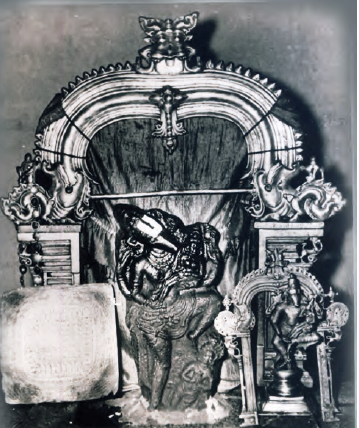
In addition to this idols of 1’ in height Panchaloha Varaha and Sri Srinivasa, some salagrams can be seen. Further 1’ height copper plated yantra, which is in chaturasrakara shape. This is in brahmi script and may be a danapatram written by Sri Venkateswara Swami. While entering the temple’s Garbhagriha we come across Lord Vishvaksena and Ramanujacharya. We can observe Vishvaksena’s Idol on the right side of the temple’s Garbhagriha and Ramanujacharya Idol to the left of temple’s Garbhagriha.
There is no dwajasthambam in this temple. As such daily poojas archana, an offering of naivedyam three times a day is being conducted as per Vaikhanasa Agama. The annaprasadams are prepared in the kitchen of Sri Venkateswara Swami temple, first to Sri Varaha Swami and later to Lord Srinivasa.
In the year 1982 from April 21 to 26 Mahasamprokshanam was conducted. The height of the dias of the presiding deity was increased. Golden makara thoranam to Swamivaru was arranged. A big golden vimana, kalasa pratistaphana programmes were performed grandly.
The Varaha Swami temple was well constructed as per agama and vastu sastras. It was divided into four parts viz., mukha mandapam antaralayam and Garbha griha. The sanctity and
the beauty of the temple attracts Pilgrims.
On the last day of every year of ‘Srivari Brahmotsavams’ i.e. Sravana star day on the eve of chakra snanam Sri Venkateswara Swami along with Sridevi and Bhudevi and Chakrattalwar come to Mukha mandapam of Sri Varaha Swami temple in a procession. After panchamrutha snapana tirumanjanam, chakrasnanam will be performed in the sacred waters of Swami pushkarini to the processional deities.
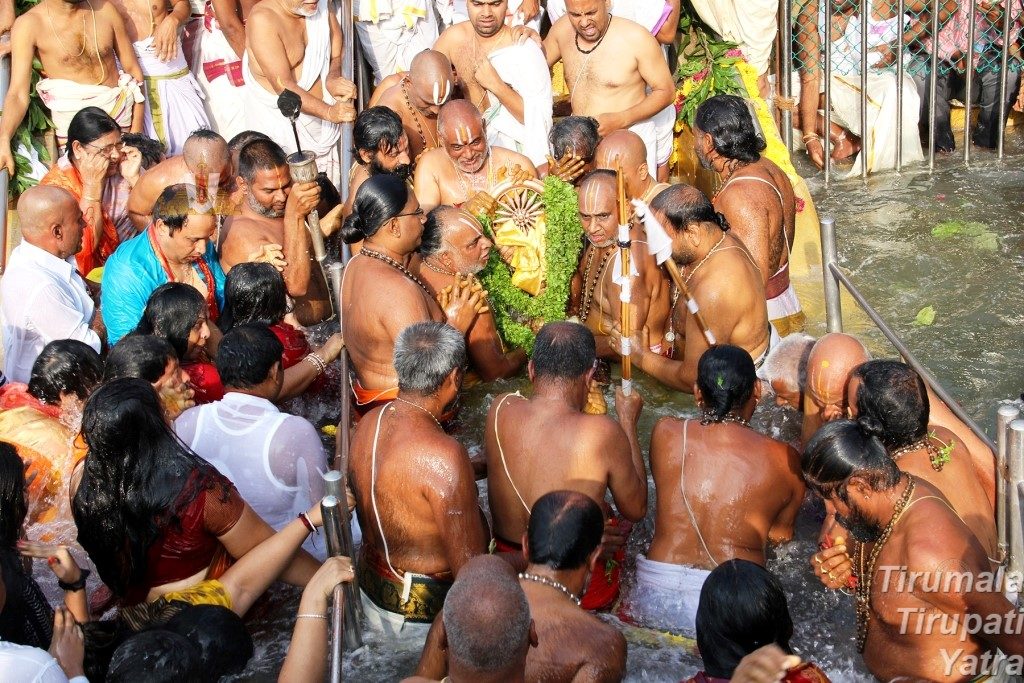
The archakas, vedaparayanadars, mathadhipathis, higher officials of TTD., employees, men, women, and children devotees in large numbers take baths in the waters. Similarly, on Rathasapthami and Mukkoti dwadasi days only Chakrattalwar will come to this Mukhamandapam. After the abhishekham, the bath will be performed in the sacred waters of Swamipushkarini.
Have the blessings of Lord Sweta-Varahaswami and Sri Srinivasa residing on Sacred Tirumala Hills
Varam Svetavarahakhyam
samharam Dharanidharam
Swava dhamshtrabhyam
dharodharam Srinivasam bhajeanisam
Possessing a high-strength body, the killer of demon Hiranyaksha, who snatched away Bhudevi, the saver of bhumi (Earth) with his curved tusks, we always pray Sweta-Varahaswami and Lord Srinivasa!!
